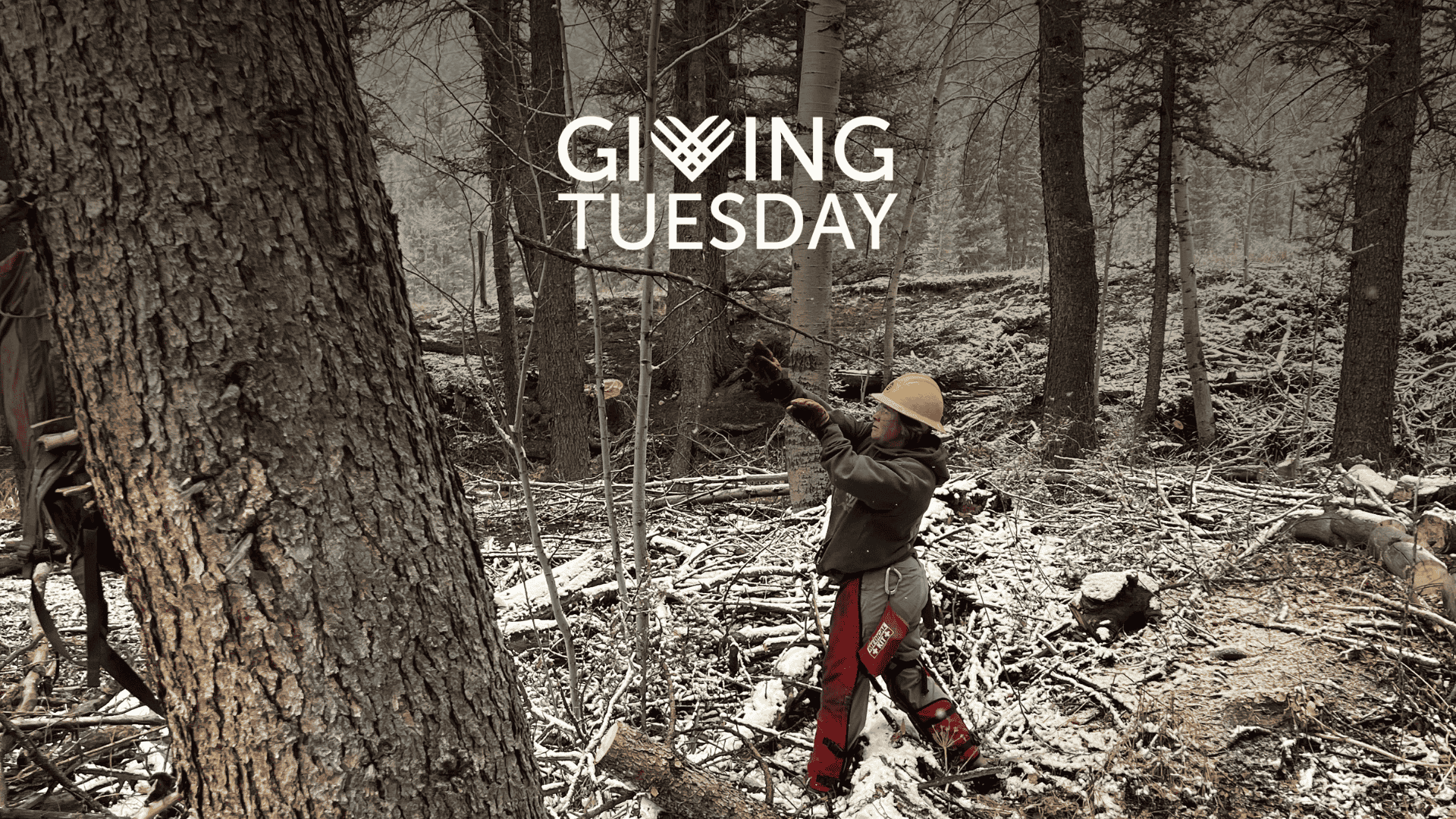Post-fire Forest Restoration: A Long-term Endeavor
NewsIn 2023 Gila National Forest took major steps toward restoring trails and watersheds damaged by the Whitewater-Baldy Complex Fire of 2012. A fast-moving, lightning-caused fire, it consumed more than 274,000 acres of the Gila National Forest, holding title as New Mexico’s largest wildfire for a decade, until it was surpassed by both the Hermits Peak-Calf Canyon Fire and the Black Fire in 2022.
An extreme rain event in September 2013 caused extensive flooding that destroyed the historic Catwalk Trail suspended above Whitewater Creek, as well as many other trails on the west side of the Gila Wilderness. The flood unleashed landslides and debris flows that scoured the bottoms of gullies and streams, depositing sediments, and disrupting habitats and watershed dynamics on many area streams. While the Catwalk Trail was reconstructed and reopened in 2016, many Gila Wilderness trails within the fire perimeter were damaged beyond the capacity of local crews to deal with and have been lost to use for many years. The fire and post-fire flooding changed the face of the Gila and brought unwanted change to a landscape that will never again, in our lifetimes, be what it was before the fire.
However, restoration efforts over the past eighteen months are beginning to bear fruit. Little Turkey Creek, tributary to Willow Creek, is located inside the northern boundary of the Gila Wilderness. Most of its forest cover was lost during the Whitewater-Baldy Complex. From November 2022 to November 2023, a series of volunteer and partner stream restoration projects took place on Little Turkey Creek.
Volunteers moved rocks and logs to construct in-stream features that improve habitat diversity, manage flow and sedimentation, and stabilize streambanks; and planted nearly 2,000 willow canes that will provide cooling shade as they grow. The overall goal of these projects is to improve fisheries habitat and make the stream channel more resilient during high flows. Eric Head, Gila Trout Project Manager for Trout Unlimited was among a variety of volunteers and organizations who participated in the projects.
“Trout need clean, cool water and a healthy surrounding ecosystem in order to survive. Their abundance is a direct reflection of ecosystem health in headwater streams – the same streams that we rely upon to grow crops and livestock, keep people hydrated, and allow industry to survive,” said Head. “The Little Turkey Creek restoration project is a perfect example of the kind of work that Trout Unlimited wants to be a part of. It takes a great deal of background work such as environmental review, permitting and paperwork, professional planning, and logistics, which are exactly the kind of organizational skills that TU brings to bear in the name of protecting cold water streams across North America.”
Project monitoring in Little Turkey Creek has found some successes already, with abundant wetland plants and grasses growing along streambanks, 90% survival of willow plantings, and sediment collecting behind more than 150 one-rock dams and other features that were constructed by volunteers. Serendipitously, a beaver, nature’s wetland construction expert, has built a large dam near the confluence of Little Turkey Creek and Willow Creek, creating a sizable pool where adult-sized Gila trout were observed.
Additional restoration projects began on Willow Creek last fall. Heavy equipment was used to move logs and boulders to create riffles and pools, install mid-channel rock clusters, harden and lay back the slope of steep banks, and install log features. Restoration projects on Willow Creek and Little Turkey Creek will continue this spring and beyond.
The emphasis on watershed restoration brought attention to the condition of range fencing in the area, which was failing to keep cattle out of the riparian restoration areas. The barbed wire fences had been damaged by fire, flooding, and fallen trees, and the amount of work needed was beyond routine fence maintenance. In August 2023, a group of forest staff supplemented previous work by permittees on the Copper Creek and T-Bar allotments to rebuild about 8 miles of range fence in the Willow Creek area. The repaired fencing will ensure watershed improvements will not be set back by livestock trampling and foraging. So far, the efforts appear to be successful, as no more cattle have since been spotted in Willow Creek.
The forest and partners are also ramping up efforts to restore many miles of trails that were destroyed by flooding, with emphasis on restoring trails accessed from the west side of the Gila Wilderness.
“I was shocked when I learned that trails lost to fire and flood a decade ago are still largely inaccessible,” said Gila National Forest Supervisor Camille Howes. “As we are now working on recovery from the Black Fire, I am determined not to repeat that mistake, while also restoring access to trails lost to post-fire flooding after the Whitewater-Baldy Complex.”
In October 2022, a wilderness trail crew from Montana came to the Gila to help reopen the 12-mile Crest Trail #182 from the Sandy Point Trailhead to the lookout at Mogollon Baldy. Monumental effort was required to cut out more than 2,300 down logs using only hand tools. Trail and fire crews from the Glenwood and Wilderness ranger districts collaborated in spring 2023, logging it out again to keep the trail open.
In summer and fall 2023, trail crews from Conservation Corps New Mexico teamed up with the Glenwood trail crew to begin the colossal task of reopening the Whitewater #207 and South Fork Whitewater #212 trails. Nic Forest was one of the crew leaders for Conservation Corps New Mexico last fall.
“One of the most rewarding aspects of working on the Whitewater Canyon trail this fall was that they were able to repair a trail that was previously thought be a lost cause in one of our nation’s national forests,” said Forest. “This trail has been inaccessible to the public for so long and it’s really exciting to work on a project that you know the public can hike on, backpack on, and so that more people across New Mexico can enjoy all the wonders of the first designated wilderness in the United States.”
On the Whitewater Trail, the combined crews spent four, eight-day hitches removing brush and debris and cutting new trail through an extremely flood-damaged section, where 16 landslides had gouged up to 40-foot-deep gullies. Their work opened up trail access to a campsite 2.2 miles east of the Powerhouse junction for the first time in a decade. On the South Fork Whitewater Trail, the crews spent another three hitches removing logs, cutting out thick brush, and reconstructing trail tread on 4 miles of trail to a campsite at Tennessee Meadows.
The Gila Chapter Back Country Horsemen are longtime partners in trail maintenance and improvements. Along with volunteers, they completed heavy maintenance on the Holte Apache Trail #181 from the trailhead to its intersection with the Johnson Cabin Trail #225 and South Fork Whitewater Trail #212 – a total of about 7 miles – as well as nearly 5 miles of the Little Whitewater Trail #214 and about 3 miles of the Rain Creek Trail #189 in summer and fall 2023.
“We host volunteer trail projects because we believe it is important for people to be able to experience these wild places and find rejuvenation and inspiration,” said Gila Chapter Back Country Horsemen Volunteer Coordinator Mellissa Green.
Back Country Horsemen member and trail volunteer Betsy Holdsworth added, “More and more people crave the experience of being able to be in nature and want to explore the unique beauty and terrain of the Gila. Repeat use off-trail by hikers or horses can quickly destroy the fragile terrain of this largely desert ecosystem. A well mapped trail is efficient and safe and is an invitation to journey into the wild.”
In all, about 30 miles of trail on the west side of the Gila Wilderness have been reopened to hikers over the past year and a half, with many more projects, trails, and miles to go before access is fully restored. There is a lot of work ahead, but the first steps are often the most difficult, and those are firmly behind us.
Partners and volunteers who participated in past and upcoming activities with the Gila National Forest include Trout Unlimited, New Mexico Game & Fish, New Mexico Environment Department, New Mexico State University students, Catron County, Rocky Mountain Youth Corps, Conservation Corps New Mexico, Wild Arizona, JEB Outfitters, Natural Channel Design, Amigos Bravos, Gila Chapter Back Country Horsemen, Latino Outdoors, grazing permittees, and private citizens. Many other volunteer projects are planned in spring, summer, and fall 2024. Watch for opportunities to join in on the hard work and fun – words that are not mutually exclusive when the work happens on the Gila National Forest.




